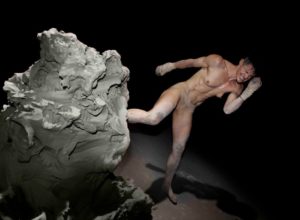Performance art offers to artists and audiences a rich language to resist and challenge sources of power and to make the invisible visible.
Cassils—a Los Angeles-based artist originally from Montreal who will perform their Becoming an Image at UVic this month and then follow it up with a talk the next night at Legacy Gallery (the venue has been moved from Open Space)—says that live performance is a tremendous artistic tool that allows connection through all of the senses and has the possibility to create empathy and resonance that other artworks mediated through technology are not as effective at doing.
“I’ve been drawn to live performance because of its viscerality and its immediacy,” says Cassils. “That’s something that can be a bit safe about experiencing an artwork that’s pinned to a wall in the sort of sanctity of a white, removed gallery space.”

Becoming an Image was initially made as a site-specific work in 2012 for the ONE Archives Foundation in Los Angeles, the oldest active LGBTQ organization in the US. Cassils was invited to fill the missing trans representation in the archives.
“Like most archives, this was filled with the work, in this case, of dead gay white guys,” Cassils says. “So, looking through the archives, they realized there really was not much representation.”
From the start of the project, Cassils approached representation from a critical standpoint and wanted to speak to the ways in which certain histories were given visibility by being included in the archives while others were left in the dark. Playing with the idea of “visible” and “invisible,” they converted the ONE Archives into a total black-out chamber—once in the space, the audience was plunged into total darkness. Cassils and a photographer then came into the room, and Cassils attacked, with full force, a 2,000-pound mass of clay in the middle of the room that neither the artist nor the audience could see. The only moments in which the audience and the artist were able to see what was happening was when the photographer took photos with a flash.
“You become so aware of all of the negative moments—by that I mean all the moments we are not receiving visual stimulus and yet you are aware that something is occurring,” says Cassils. “So, it’s speaking to all the histories and statistics and possible lived experiences, in this, outside of the realm of documentation. And, so, yes, it is speaking about trans identity, and yes, it’s speaking about this sort of silent violence against trans identity, but it’s also speaking about whose histories are deemed important and whose are not, essentially; whose are captured and whose are not.”
Cassils says that art can take on a very important role in the United States today.
“In the US political climate that I live in, to perform a piece like [Becoming an Image] after the election here, it’s an act of defiance, an act of resilience, and an act of resistance. And it’s an act of struggle, but it’s also an act of self-making, it’s an act of agency. And it’s also calling out these larger power structures.”
Becoming an Image
7:30 pm Wednesday, March 7
Free, Room 150,
UVic Visual Arts Building
uvic.ca/events
Artist talk with Cassils
7:30 pm Thursday, March 8
Free, Legacy Gallery
uvac.uvic.ca
